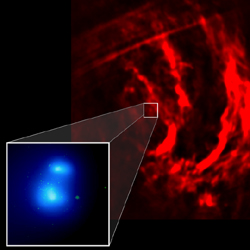June 6, 2001, 9:30 am PDT

The Arches Cluster
Credit: X-ray: NASA/CXC/Northwestern/F.Zadeh et al., IR: NASA/HST/NICMOS, Radio: NRAO/AUI/NSF/C.Lang
Press Image and Caption
Near the crowded core of the Milky Way galaxy, where stars shine so brightly and plentifully that planets there would never experience nighttime, astronomers have found a new phenomenon: a cauldron of 60-million-degree gas enveloping a cluster of young stars.
Professor Farhad Zadeh of Northwestern University and his collaborators used NASA's Chandra X-ray Observatory to trace the gas around the Arches cluster, a well-studied region of star formation that is home to some of our Galaxy's largest and youngest stars.
"This is the first time we have seen a young cluster of stars surrounded by such a halo of high-energy X-rays," said Zadeh in a press conference at the American Astronomical Society in Pasadena, CA. "This supports theoretical predictions that stellar winds from massive stars can collide with each other and generate very hot gas."
Massive stars, newborn stars, and stellar winds have long been known to emit X-rays. The Chandra results are significant because they identify this new type of mechanism of colliding winds to generate X-rays as energetic as those seen in distant starburst galaxies, which are known for their furious pace of star production.
The Arches cluster is about 26,000 light years from Earth and only about 1 to 2 million years old. It is also less than 100 light years from what is thought to be a supermassive black hole in the center of our Galaxy. The cluster contains 150 hot, young stars, known as "O" stars, concentrated within a diameter of one light year, making it the most compact cluster known in the Milky Way galaxy.
The density of stars makes the region in and around the Arches cluster a microcosm of what is likely occurring in starburst galaxies.
"The Arches cluster is one of the best 'local' analogues of starburst galaxies-- the most prodigious stellar nurseries known," said Casey Law of the Harvard-Smithsonian Center for Astrophysics. "Yet the Arches cluster is in our backyard, not millions of light years away."
Starburst galaxies are known for creating huge hot bubbles of gas that escape from the galaxy. In a similar way, Chandra observations of the Arches clusters may provide clues to the origin of a much larger cloud of hot gas known to exist in the center of the galaxy.
"Our data suggest that the gas within the Arches cluster may get so hot that it escapes from the cluster," said Cornelia Lang of the University of Massachusetts. "The Arches and other clusters like it may contribute to the reservoir of mysterious hot gas long observed near the Milky Way."
Zadeh and collaborators intend to search for X-ray emission from other clusters of stars near the Galactic center and compare this to newer, longer Chandra observations of the Arches cluster.
Chandra observed Arches cluster region with its Advanced CCD Imaging Spectrometer (ACIS). The research team for this investigation also included Casey Law and Antonella Fruscione from the Harvard-Smithsonian Center for Astrophysics; Cornelia Lang and Daniel Wang from University of Massachusetts; Mark Wardle of the University of Sydney, Australia; and Angela Cotera from University of Arizona.
The ACIS X-ray camera was developed for NASA by Penn State and MIT. NASA's Marshall Space Flight Center in Huntsville, AL, manages the Chandra program. TRW, Inc., Redondo Beach, California, is the prime contractor for the spacecraft. The Smithsonian's Chandra X-ray Center controls science and flight operations from Cambridge, MA.
Images associated with this release are available on the World Wide Web at:
MEDIA CONTACTS
Dolores Beasley
Headquarters, Washington, DC
Phone: 202/358-1753
Steve Roy
Marshall Space Flight Center, Huntsville, AL
Phone: 256-544-6535
Megan Watzke
Chandra X-ray Observatory Center, CfA, Cambridge, MA
Phone: 617-496-7998



